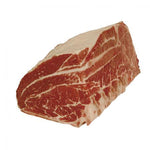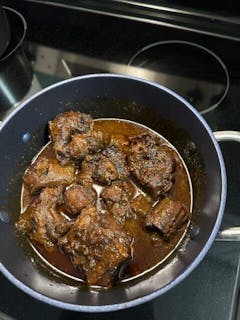One of the best beef cuts for pot roast or cut into chunks for stew, slowly simmer/ braise in a seasoned broth in a covered container for optimal tenderness.
Green Stream: This item comes from one of our prime animals; 100% Grass Fed and Grass Finished, No Artificial Growth Hormone, No Antibiotics: Excellent flavour and tenderness.
These Grazing Days Farm Protocols Apply to This Product
People often ask us about our animal husbandry practices. How do we raise them? What do we feed them? Below you will find an articulation of our animal husbandry protocols. Additionally you will find here our protocols for land management and our protocols for processed products like sausages, burger patties, ham, bacon and pâté.
This is a complete list of the protocols that we follow on the farm. Please note that every protocol does not apply to every animal on the farm (there are a few pig specific protocols and others that are cow specific). To help clarify what protocol applies to what product we sell, we have added a list of product specific protocols to each product in our store. Also please do not hesitate to reach out to us for clarification, or to visit the farm this growing season during one of our farm tours.
Animal Husbandry Protocols
Grass-Fed, Grass Finished (No Grains)
The cattle on our farm only eat grass. When they are young they drink milk from their mother, but other than that they eat fresh grass in the summer and either dried grass (hay) or fermented grass (haylage) in the winter. Our cattle do have free access to 20 different minerals that they use to balance any nutritional short-comings. Our cattle are slaughtered in the fall—when they are naturally at their fattest as they have built up fat reserves to get through the winter—when they are between 24 to 26 month of age and physically mature. Our cattle never receive grain.
Pasture-Raised
All meat that Grazing Days sells comes from animals that were raised on pasture. This means that they have the space to move freely and they also have a choice of what grasses, legumes, and weeds they eat. It also means that they live in fresh air and in a bio-diverse environment with plenty of sunlight.
Certified Organic Grains for pigs
Since pigs do not have the physiology that will allow them to live, grow and thrive on grass alone like cattle are able to do, we do supplement their diet of grasses, legumes, weeds and pasture rooted goodness with a grain ration from time to time (when things like whey or spent grains are not available in sufficient quantities). We make sure to only feed grain that is certified organic.
Certified Organic Grains for Chickens
Since chickens do not have the physiology that will allow them to live, grow and thrive on grass alone like cattle are able to do, we do supplement their diet of grasses, legumes, weeds and grubs with a grain ration. We make sure to only feed grain that is certified organic.
Cheese Waste Recycling (Whey)
Protein is the principal nutrient that pigs are unable to get from eating grass. Luck would have it that our local artisanal cheese maker used to dump about 7000 litres of protein rich whey down the drain every week. When we feed this whey to our pigs, not only are we able to balance the pig’s nutritional requirements with their grass intake, we are also returning valuable nutrients back to the land by closing the land – grain – cow – milk – whey – pig – manure/urine – land cycle.
Vegetable Waste Recycling
Rooted Oak is a certified organic vegetable operation that grows vegetables on our farm. They use manure from our animals to fertilize their fields and in return any vegetables that don’t meet Rooted Oak’s excellent quality standards go to the pigs, who gladly take those vegetables and turn them into manure. The only downside is that sometimes the pigs have onion breath...
Beer Waste Recycling (Spent Grains)
From time to time, a local brewery calls and asks us to take away the spent grains that are left over from their beer making. Since spent grains are high in fiber and digestible protein, they make a great addition to the pig diet and it also allows us to bring valuable nutrients back to the land (that would otherwise be land-filled) by closing the land – grain – spent-grain – pig – manure/urine – land cycle.
No Antibiotics, No Pharmaceuticals
Under normal circumstances we do not use antibiotics nor pharmaceuticals on our animals. We never use antibiotic or pharmaceuticals prophylactically.
Having said that however, from time to time (in about 3% of animals on the farm) we do use antibiotics for the therapeutic treatment of an infection to ensure animal well-being AND if there are no other treatments available. In the cases where we do use antibiotic or other pharmaceuticals, we remove that animal from our regular meat production stream.
We have also made a commitment to the animals that we husband on the farm, that we will never ship them off to a feedlot elsewhere if they are no longer part of our “no antibiotics” production stream. Instead, we keep them on the farm, and raise them until they are mature and market their meat through a different production stream.
All meat that we sell through the “Green Production Stream” has never had antibiotics.
Meat that is sold through the “Blue Production Stream” either comes from animals who received a therapeutic treatment of antibiotics, or comes from animals who were not born on the farm and we don’t know their treatment history.
All this to say, we will be transparent through our Blue and Green production streams whether the meat comes from an animal therapeutically treated with antibiotics.
No Growth Hormones
We do not give our animals any artificial growth hormones or any substances that may help them grow faster than they would normally. We allow our animals to mature at the rate their bodies naturally mature.
No GMOs
We do not feed any GMOs (Genetically Modified Organisms) to our animals.
No animal by-products
We never feed any animal by-products.
Animal Welfare
We do our utmost to ensure that all the needs of the animals are met to be healthy, to grow, to thrive, to be stimulated, to relax and to express their species appropriate behaviour (ie – pigs root, chickens scratch, etc.) We care about these animals deeply and we know a lot about how our animals are doing by observing their body language and can adjust our management accordingly.
When our animals leave the farm to go to the abattoir, we thank their spirits for their sacrifice to feed and sustain us and we re-commit ourselves to the unwritten contract between domesticated animals and human beings – where we will ensure the survival of their species in return for their sacrifice in feeding us.
Mimic Nature
Mimicking nature is a guiding principle on our farm. We look to how the wild cousins (such as caribou, buffalo or wild boars) of our cattle or pigs would behave in the wild in order to determine how we manage them on our farm. We know for example that in nature, in this part of the world, calves and fawns are born in June and so we aim to have the calves on our farm start being born in June.
Low Stress Handling (incentive Based)
The most stressful time for farm animals is when they are being handled or moved (think going to the doctor or dentist). We take great care to think through ways that we can use an animal’s instinct to achieve the outcome that we would like to achieve. For example, when we need to sort some animals in the corral, we take a few days / weeks to graze the whole herd towards the corral, rather than chasing them there, or we make a cozy pig nest inside the trailer a few days before we want to load the pigs into the trailer so they get used to it and start sleeping in the trailer prior to them needing to be loaded into it.
Outdoor - Raised
Our cattle live outdoors every day of the year. We ensure that the cattle have access to fresh water, fresh grass or hay, and shelter from the wind. In the summer they live on fresh pasture and in the winter they live on snow-covered pasture. These animals are well insulated (they are wearing thick leather coats and have a fluffy hair coat) – so much so that often when it is snowing, snow will accumulate on their backs. As long as they have protection from the cold, and access to good quality feed, cattle are quite comfortable and thrive in the cold. Being outside in the fresh air and in the sunlight is an excellent way for us limit disease and pathogens and enables us to keep our herd healthy. The cattle on our farm live a winter life very similar to their wild buffalo and caribou cousins.
Land Management Protocols
Regenerative Practices (Builds Soil)
Our livelihood depends on the quality of the soil on our farm. Prior to our farming this land, some of the agricultural practices used on this land (such as the use of chemical fertilizers and pesticides, tilling the land, continuous grazing practices, etc) depleted the health of the soil. Through the use of our managed grazing techniques, we are able to restore the balance in our soils between its physical, biological and chemical properties, to a place where the soil ecosystem can thrive. A thriving soil ecosystem can filter and infiltrate rain water to rejuvenate aquifers, can sequester carbon, can provide a buffer against too much or too little rainfall, and can provide the plants that grow on and in it with the nutrients they need to grow and be healthy. Healthy and nutrient dense plants feed our animals and keep them healthy and nutrient dense as well. Although this process of soil regeneration takes years, five years into this process, we are starting to see the results of our efforts.
Sequesters Carbon
The thing that we find most exciting about what we do is the sequestration of carbon in the soil. Climate change is real and we as living beings on this planet are feeling the effect of too much carbon in the atmosphere – carbon that had been locked away in the Earth’s crust in the form of fossil fuel, and carbon that had been locked away in soil, but has been released into the atmosphere through destructive agricultural practices (such as tillage, leaving soils exposed to the elements, the use of chemical fertilizers and pesticides, etc). With the managed grazing techniques we use on the farm (mob grazing or sometimes called adaptive multi-paddock grazing) however, we work with our grasslands and animals to capture carbon from the atmosphere (in the form of carbon dioxide and methane) and sequester them in the soil. Early research (Stanley, 2018) shows that grazing techniques such as ours can increase the soil carbon by 3.5 tonnes of carbon per hectare per year, which on our 320 acres (130 hectares) of grassland, could mean 448 tonnes of carbon that we can sequester in a year. That is a pretty hopeful proposition: we can grow delicious food that is healthy and combats climate change at the same time – awesome.
https://www.sciencedirect.com/science/article/pii/S0308521X17310338
Processed Product Protocols
Gluten-Free
This product is does not contain gluten.
Nitrite/Nitrate Free
This product is made without nitrates and without nitrites period – neither from artificial nor from natural sources. As a result, you will find that our version of ham, bacon, or pâté has a brown colour instead of the pink that you may be used to from the store-bought version. You will also find that the nitrate-free and nitrite-free version has a slightly different texture.









